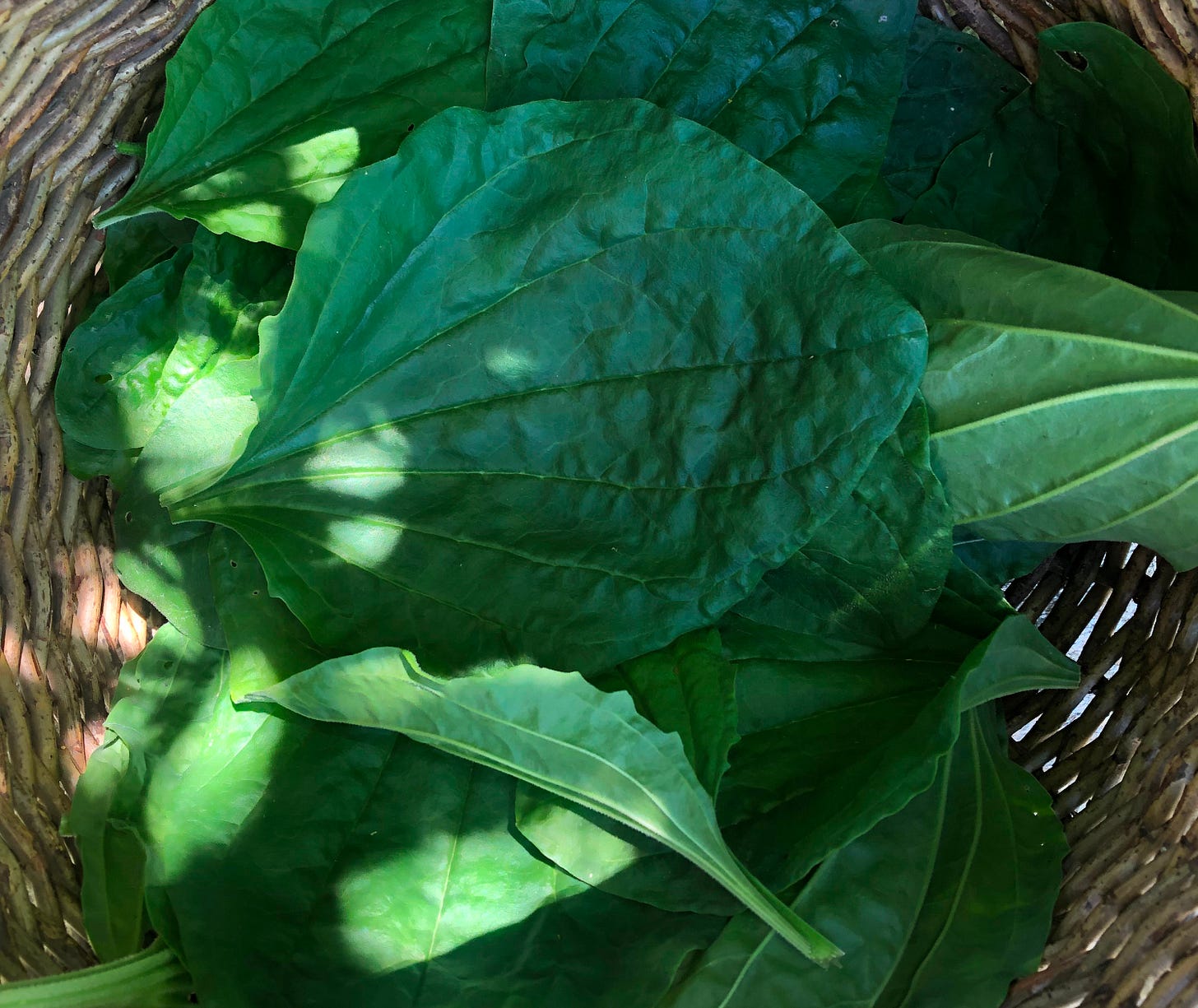Plantain
Plantago major
Oooh, I love Plantain. It’s one of my favorites. Another more domesticated weed, edge of the hedge kind of plant. The seeds are easily carried in the mud of one’s boot tread and is often seen on the beginnings of trailheads. It pops up in lawns and gardens and is easily recognizable. The leaves are dark green and rather thick, almost leathery feeling. The leaves come up from a central middle, like a Dandelion does. Plantain (P. major) leaves are oval shaped with noticeable veins running up from the short, celery-like stem into the leaf. When the stem and leaves are pulled apart, stringy veins become apparent. Those strings help indicate you have the correct plant.
There are a few different Plantain species that I’m aware of, I’ve only grown and used Plantago major—that is until 2024. That year, a stranger plant arrived in my veggie garden. I had never seen this plant before but fairly quickly identified it as Ribwort, or Narrow-leaf Plantain (Plantago lanceolata). I’ve now come to realize that I like growing this plant (with its similar uses) over P. major! So far it’s staying a bit more tidy instead of spreading so quickly. And it seems to like the dryer climate more so than the other. We’ll see how it all transpires, but I’m thrilled it decided to show up unannounced in my garden!

Plantain is a go-to for bug bites of all sorts including bee & wasp stings! It also has an affinity for sprained ankles, botched knees & sore shoulders. You can readily reduce inflammation using a topical poultice of the leaves.
This is my favorite technique when dealing with a larger area of inflammation as seen in a really infected white socks fly bite or swelling due to an injury.


PLANTAIN LEAF POULTICE
Materials: Sauce pan (metal or glass), water, Plantain leaves, cheesecloth/handkerchief
Gather enough leaves to fully cover the area, plus a little more. Depending on the size of the leaf (they grow larger when tended in a garden than when mowed over in a lawn) use a sauce pan that can hold the leaves length.
Fill saucepan with a ½ inch or so of water.
Bring water to a simmer. ADD LEAVES.

Using a chopstick or fork, make sure water covers the leaves.
Simmer for about 1 minute ~ watching the leaves carefully. There is a moment when they become brighter, a vibrant green, and that is when you want to take them out.
Have a piece of flannel or cheesecloth, cotton towel or a handkerchief handy that you’ll use to keep the leaves in direct contact with the skin. This will stain material, don’t use your favorite hanky.
Apply the Plantain when warm, but not too hot to the touch. Wrap the affected skin/area with the leaves, layering as needed, unfold the leaves to help them conform to afflicted region.
Gently wrap the leaves with cheesecloth, towel, etc. For extra benefit, soak the material in the ‘tea’ that was made by simmering the leaves and then wrap another towel around that.
Elevate if swelling is in extremities and it feels good.
In severe cases, change out Plantain leaves every half an hour to an hour. For less extreme cases, 1-3 x/day usually helps. Sometimes you will feel better after the treatment and be back on your feet, only to be reminded later that it still hurts—keep up the Plantain poultices and it really will help so very much, with bad bug bites especially.
I’ve recommended this to countless folks, and it’s kept many people from choosing to go into the hospital/clinic for a treatment that will cost far more than locating Plantain leaves near you, (and the medical route is usually less effective—though not always)…Consistency is important here, herbal medicine is usually not a “one and done” sort of treatment. If things start going south, tune into yourself and determine if another route is more beneficial.
Plantain oil is an awesome helper for irritations, inflammations and itchy bites as well ~ I’ve included the how-to recipe in Haven Making June (it’s different than most). This gives you added shelf-life for retaining the medicine of Plantain*, and allows you to take it with you as needed. Plantain is the main ingredient of my renowned Bug Bite Salve. You can make your own too if you want!
*Dried Plantain doesn’t retain it’s medicine very well. Six months or so is about it. I’ve not had luck air-drying (that was in moist SE Alaska though), so using a dehydrator may be helpful.





I love Plantain too! It really helped my daughter when she had an abscessed tooth a few months ago. I made an infusion of the fresh leaves and had her gargle with it every few hours.
Such an amazing plant.
I am having a knee issue and will try the poultice 😀
Thanks for sharing!